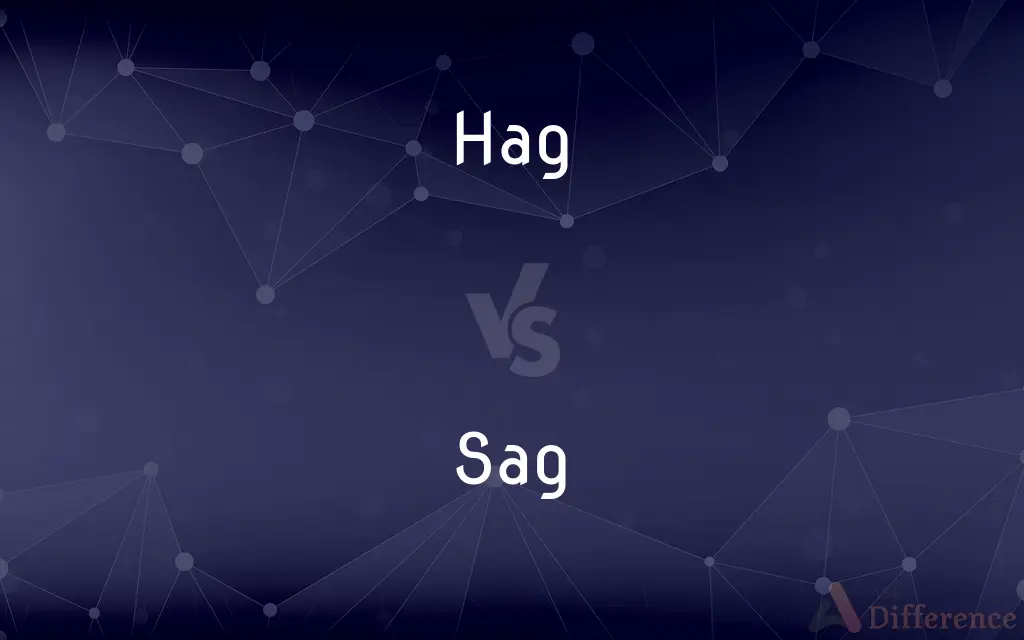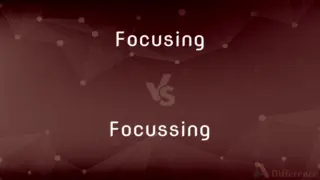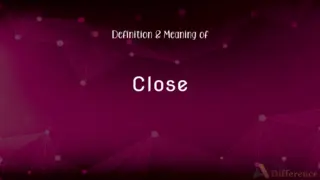Hag vs. Sag — What's the Difference?
By Urooj Arif & Maham Liaqat — Updated on May 4, 2024
A hag typically refers to an old, ugly woman, often linked with witchcraft, while sag means to droop or sink due to weight or pressure.

Difference Between Hag and Sag
Table of Contents
ADVERTISEMENT
Key Differences
A hag is often depicted in folklore as a witch-like old woman, embodying ugliness and malevolence. In contrast, sag describes the action of something bending, drooping, or sinking downward, usually due to weight or a lack of support. This term is commonly used in the context of physical objects or structures.
In literature, the term "hag" is used to convey horror or disgust, often serving as a symbol of supernatural evil. Meanwhile, sag does not carry such connotations; instead, it is a neutral term that describes a physical change or condition, such as in sagging floors or sagging spirits.
The use of "hag" can also be metaphorical, referring to someone perceived as being spiteful or manipulative. On the other hand, "sag" is used literally in most contexts, describing a factual, observable phenomenon without any implied moral judgment.
Hags are a staple in many cultural stories and myths, often associated with magic and the macabre. Conversely, sag is a practical term used in everyday language, emphasizing the natural effect of gravity on objects over time.
Culturally, the image of a hag can evoke fear or scorn, which can reflect societal attitudes towards aging and femininity. In contrast, sag simply indicates a decline or decrease in tension and is often used in technical or descriptive ways, such as in engineering or fashion.
ADVERTISEMENT
Comparison Chart
Definition
An old, ugly woman often linked to witchcraft
A droop or decline due to weight or age
Connotations
Negative, supernatural, evil
Neutral, natural, physical
Usage in Speech
Metaphorical and literal
Mainly literal
Cultural Role
Featured in myths and folklore
Used in everyday descriptions
Implications
Evokes fear, scorn, reflects societal views on aging and femininity
Indicates natural changes, often physical
Compare with Definitions
Hag
A metaphor for something undesirable or horrifying.
The mansion stood like an old hag, decrepit and foreboding.
Sag
A downward curve or dip.
The bridge developed a noticeable sag after years of use.
Hag
An old, witch-like woman.
The story featured a hag who lived in the haunted woods.
Sag
To decline in vigor or strength.
His spirits sagged after hearing the bad news.
Hag
A derogatory term for a mean or spiteful woman.
He unfairly called his kind teacher a hag.
Sag
To hang loosely or unevenly.
The curtain sagged in the middle where the rod was weak.
Hag
A woman considered to have magical powers, and usually malicious.
The hag cast a spell on the village.
Sag
To sink or droop from weight or pressure.
The old couch began to sag under the weight.
Hag
A frightening, ugly old woman.
Children avoided the rumored hag of the neighborhood.
Sag
To decrease in value or intensity.
Sales sagged after the initial product launch excitement.
Hag
A hag is a wizened old woman, or a kind of fairy or goddess having the appearance of such a woman, often found in folklore and children's tales such as "Hansel and Gretel". Hags are often seen as malevolent, but may also be one of the chosen forms of shapeshifting deities, such as The Morrígan or Badb, who are seen as neither wholly benevolent nor malevolent.
Sag
To sink, droop, or settle from pressure or weight.
Hag
(Offensive) An old woman considered to be ugly or frightening.
Sag
To lose vigor, firmness, or resilience
My spirits sagged after I had been rejected for the job.
Hag
A witch; a sorceress.
Sag
To decline, as in value or price
Stock prices sagged after a short rally.
Hag
(Obsolete) A female demon.
Sag
(Nautical) To drift to leeward.
Hag
A hagfish.
Sag
To wear one's pants with the waist below the hips, so that one's underwear is visible.
Hag
A boggy area; a quagmire.
Sag
To cause to sag.
Hag
A spot in boggy land that is softer or more solid than the surrounding area.
Sag
The act or an instance of sagging.
Hag
A cutting in a peat bog.
Sag
The degree or extent to which something sags.
Hag
A witch, sorceress, or enchantress; a wizard.
Sag
A sagging or drooping part or area
Tried to brush out the paint sags.
Hag
(pejorative) An ugly old woman.
Sag
A sunken area of land; a depression.
Hag
(derogatory) An evil woman.
Sag
A sagging area; a depression.
Hag
A fury; a she-monster.
Sag
A decline, as in monetary value.
Hag
A hagfish; one of various eel-like fish of the family Myxinidae, allied to the lamprey, with a suctorial mouth, labial appendages, and a single pair of gill openings.
Sag
(Nautical) A drift to leeward.
Hag
A hagdon or shearwater; one of various sea birds of the genus Puffinus.
Sag
The state of sinking or bending; a droop.
Hag
(obsolete) An appearance of light and fire on a horse's mane or a person's hair.
Sag
The difference in elevation of a wire, cable, chain or rope suspended between two consecutive points.
Hag
The fruit of the hagberry, Prunus padus.
Sag
The difference in height or depth between the vertex and the rim of a curved surface, specifically used for optical elements such as a mirror or lens.
Hag
Sleep paralysis.
Sag
To sink, in the middle, by its weight or under applied pressure, below a horizontal line or plane.
A line or cable supported by its ends sags, even if it is tightly drawn.
The floor of a room sags.
Her once firm bosom began to sag in her thirties.
Hag
A small wood, or part of a wood or copse, which is marked off or enclosed for felling, or which has been felled.
Sag
(by extension) To lean, give way, or settle from a vertical position.
A building may sag one way or another.
The door sags on its hinges.
Hag
A quagmire; mossy ground where peat or turf has been cut.
Sag
(figuratively) To lose firmness, elasticity, vigor, or a thriving state; to sink; to droop; to flag; to bend; to yield, as the mind or spirits, under the pressure of care, trouble, doubt, or the like; to be unsettled or unbalanced.
Hag
(transitive) To harass; to weary with vexation.
Sag
To loiter in walking; to idle along; to drag or droop heavily.
Hag
A witch, sorceress, or enchantress; also, a wizard.
Sag
(transitive) To cause to bend or give way; to load.
Hag
An ugly old woman.
Sag
(informal) To wear one's trousers so that their top is well below the waist.
Hag
A fury; a she-monster.
Sag
To pull down someone else's pants.
Hag
An eel-like marine marsipobranch (Myxine glutinosa), allied to the lamprey. It has a suctorial mouth, with labial appendages, and a single pair of gill openings. It is the type of the order Hyperotreta. Called also hagfish, borer, slime eel, sucker, and sleepmarken.
Sag
To sink, in the middle, by its weight or under applied pressure, below a horizontal line or plane; as, a line or cable supported by its ends sags, though tightly drawn; the floor of a room sags; hence, to lean, give way, or settle from a vertical position; as, a building may sag one way or another; a door sags on its hinges.
Hag
The hagdon or shearwater.
Sag
Fig.: To lose firmness or elasticity; to sink; to droop; to flag; to bend; to yield, as the mind or spirits, under the pressure of care, trouble, doubt, or the like; to be unsettled or unbalanced.
The mind I sway by, and the heart I bear,Shall never sag with doubt nor shake with fear.
Hag
An appearance of light and fire on a horse's mane or a man's hair.
Sag
To loiter in walking; to idle along; to drag or droop heavily.
Hag
A small wood, or part of a wood or copse, which is marked off or inclosed for felling, or which has been felled.
This said, he led me over hoults and hags;Through thorns and bushes scant my legs I drew.
Sag
To cause to bend or give way; to load.
Hag
A quagmire; mossy ground where peat or turf has been cut.
Sag
State of sinking or bending; sagging.
Hag
To harass; to weary with vexation.
How are superstitious men hagged out of their wits with the fancy of omens.
Sag
A shape that sags;
There was a sag in the chair seat
Hag
An ugly evil-looking old woman
Sag
Droop, sink, or settle from or as if from pressure or loss of tautness
Hag
Eellike cyclostome having a tongue with horny teeth in a round mouth surrounded by eight tentacles; feeds on dead or trapped fishes by boring into their bodies
Sag
Cause to sag;
The children sagged their bottoms down even more comfortably
Common Curiosities
What is a hag?
A hag is often depicted as an old, ugly woman, sometimes associated with witchcraft or malevolence.
Can hag be used as a compliment?
No, hag is generally used as a derogatory term.
In what contexts is sag used in everyday language?
Sag is used to describe anything that droops or declines, from physical objects to spirits.
Is sag a negative term?
Sag is a neutral term, describing a physical condition without moral judgment.
Are there positive connotations associated with hags?
Typically, no; hags are almost universally viewed negatively in cultural contexts.
How are hags portrayed in literature?
Hags are usually portrayed as menacing, magical figures in folklore and horror genres.
What might cause a market to sag?
A market might sag due to economic downturns, decreased consumer confidence, or external shocks.
How do modern interpretations of hags differ from traditional ones?
Modern interpretations sometimes redeem hags, portraying them more sympathetically or humorously.
What cultural significance does a hag have?
Hags are embedded in cultural stories and myths, often symbolizing societal fears about aging and the supernatural.
What does it mean to sag?
To sag means to droop, sink, or decline, typically under weight or due to a decrease in strength or tautness.
Does sag refer only to physical objects?
While commonly used for physical objects, sag can also describe non-physical declines like morale or market trends.
How do children's stories use the character of a hag?
In children's stories, hags often serve as antagonists or cautionary figures.
What can be done to prevent a physical object from sagging?
Preventing sagging typically involves ensuring adequate support and maintenance to handle the weight or stress.
What does a sag in a structure indicate?
A sag in a structure usually indicates a structural weakness or failure.
Can the term sag apply to emotional states?
Yes, emotional states such as spirits or morale can also sag.
Share Your Discovery

Previous Comparison
Week vs. Weak
Next Comparison
Pneumonia vs. PleurisyAuthor Spotlight
Written by
Urooj ArifUrooj is a skilled content writer at Ask Difference, known for her exceptional ability to simplify complex topics into engaging and informative content. With a passion for research and a flair for clear, concise writing, she consistently delivers articles that resonate with our diverse audience.
Co-written by
Maham Liaqat












































